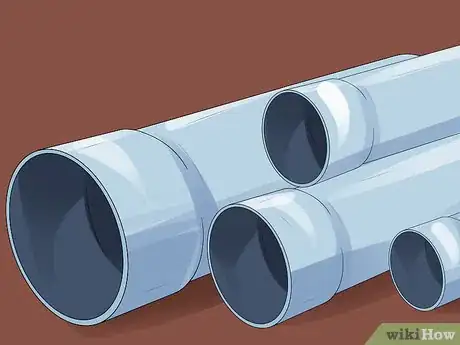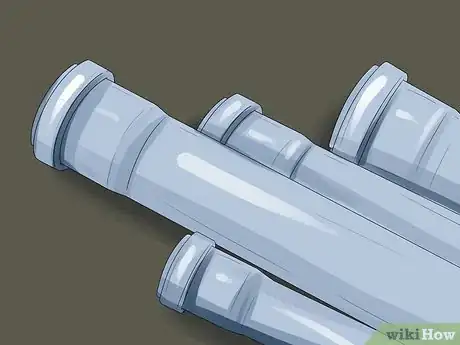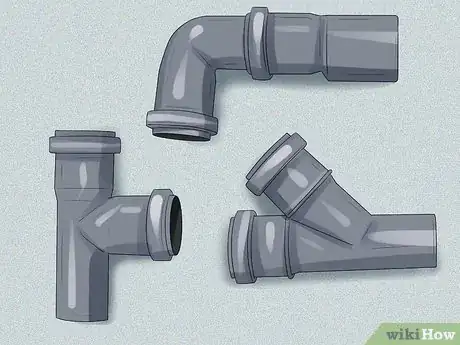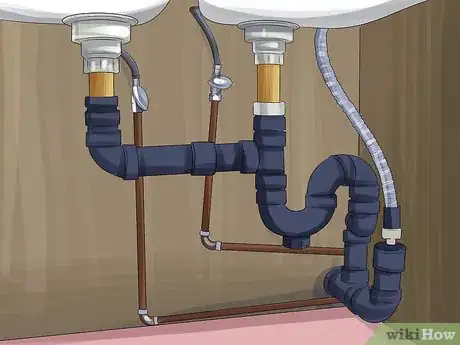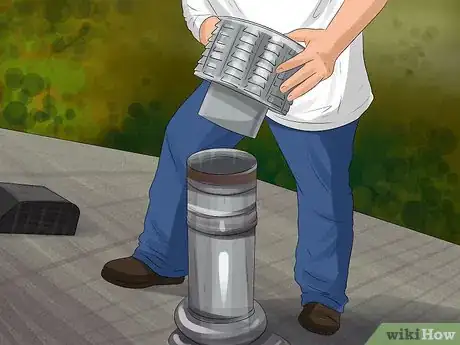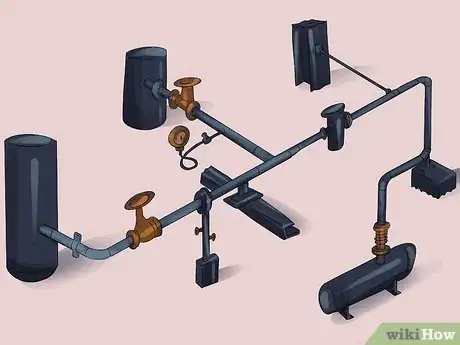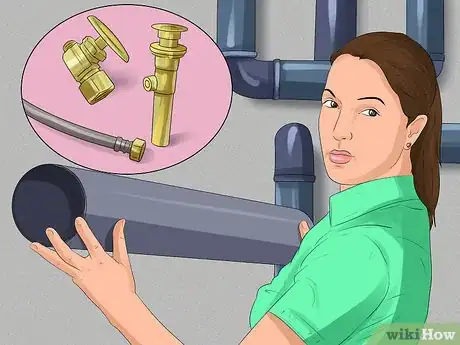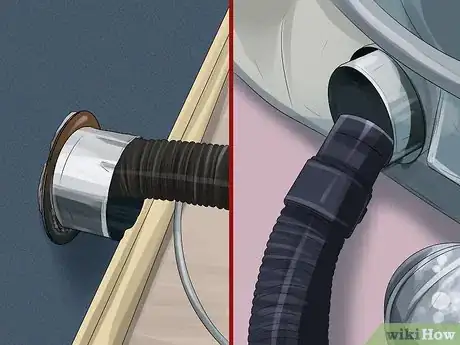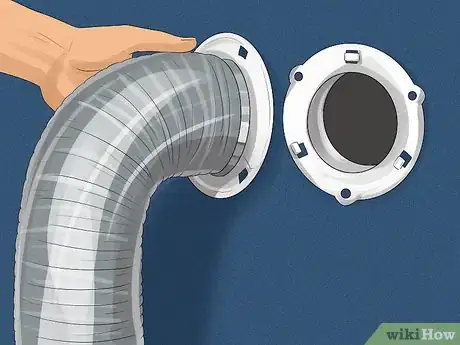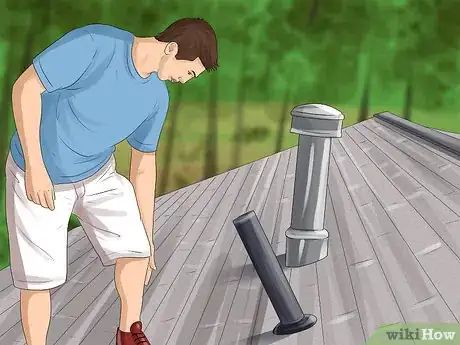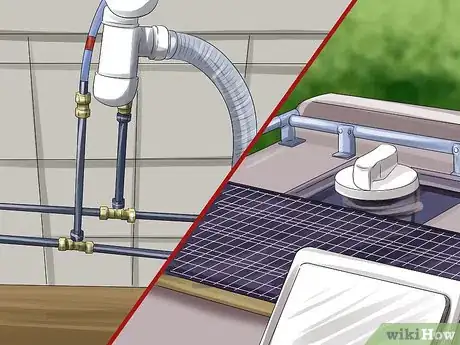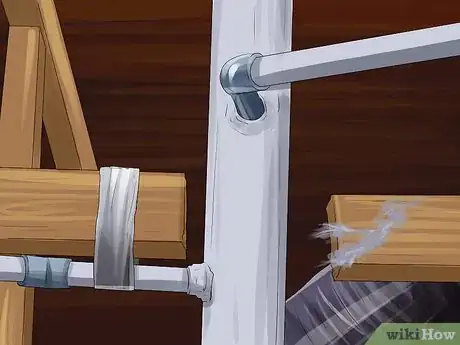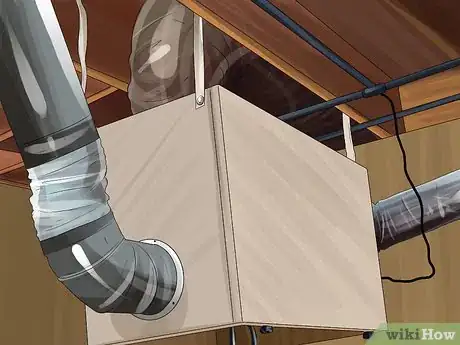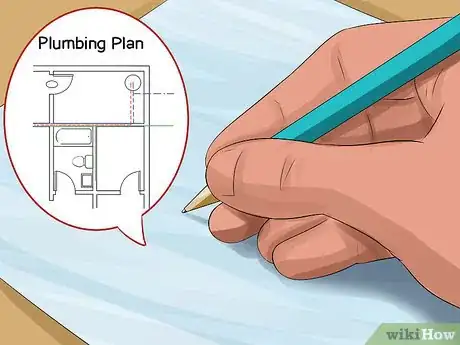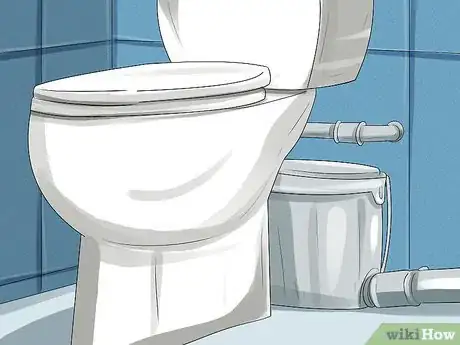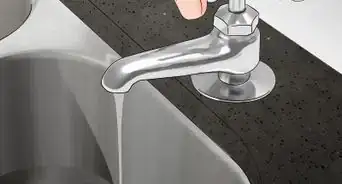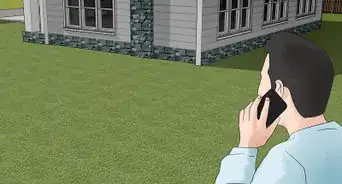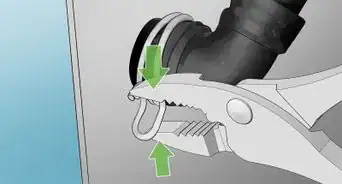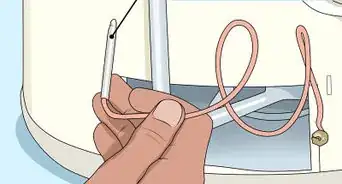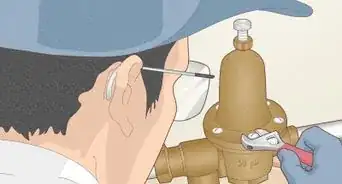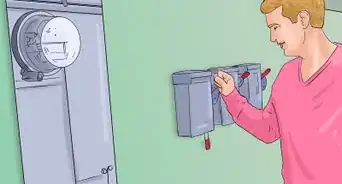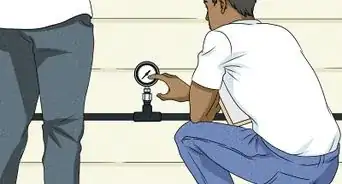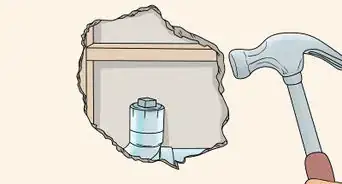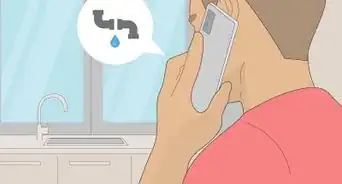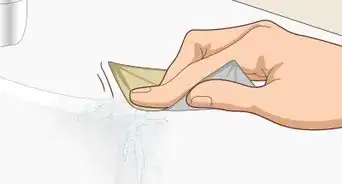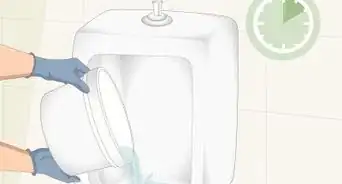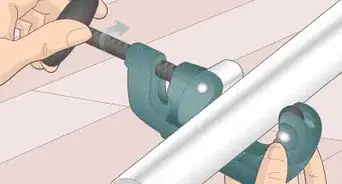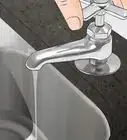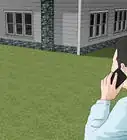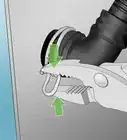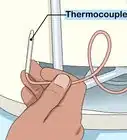This article was co-authored by David Balkan. David Balkan is a Professional Plumber, CEO of Balkan Sewer and Water Main Service, and President of Balkan Sewer and Drain Cleaning. As a hands-on owner of these companies for over 40 years, David is knowledgeable about water service lines, sewers, and drain line issues. David is a Committee Chairman of the Master Plumbers Council and has sat on the Executive Committee of the Sub Surface Plumbers Association of New York for over 30 years. His knowledge and solution-oriented approach contributed to Balkan Sewer and Water Main Service being the largest and most trusted service in New York City and the recipient of the 2017 Angie’s List Super Service Award.
This article has been viewed 465,403 times.
Proper ventilation is an important part of a plumbing system. Every plumbing fixture, from a toilet to a shower, needs to be connected to ventilation piping. Ventilation pipes prevent a vacuum from being formed in the drain system, allowing waste or water to flow smoothly through drain pipes. The pipes also allow harmful gases and unpleasant odors to be drawn from a home.
Steps
Understanding the Basics
-
1Familiarize yourself with local plumbing and building codes. These will have restrictions about the size and material of your pipes, the distance between certain fixtures and vent pipes, and the placement of ventilation. Some codes also require permits or professional help for certain projects. Make sure you understand your local codes in detail before beginning your project, and consult a local plumber if you have questions or want advice.
- Building codes change often to reflect current knowledge about safe and effective materials and building standards. Make sure you use the most recent local codes.
-
2Choose a pipe material for your ventilation system. Consider which pipe material best fits your needs, budget, and any existing piping. Most ventilation systems use small pipes less than ten inches in diameter, which allows plastic pipes like PVC or ABS pipes. In certain situations these can lack strength or durability, so copper, steel, or cast-iron pipes are also available. In choosing a pipe, consider strength, durability, flexibility, weight, resistance to corrosion, and methods for joining pipe.
- Both PVC and ABS pipes are non-toxic and resistant to abrasion. ABS pipes are easier to install than PVC, and are tougher and more rigid, but are also more likely to warp or deform in the sun. PVC pipes are flexible but durable. Both kinds of plastic pipe are cheap compared to metal or other pipes.[1]
- Consider the pressure class of the pipe. If you anticipate a lot of pressure in your pipes, go for a higher pressure class. For most projects, class 160 or 200 PVC is sufficient. The cost difference between the two classes is negligible, so people often choose the heavier duty 200 class pipe.[2]
Advertisement -
3Consider size constraints. The size of pipe you use both for ventilation and for drain or waste pipes dictates the number of fixtures you can tap into the pipes. It also limits the distance between fixtures and their sewage pipes. Larger pipes will give you more freedom in terms of both distance between fixtures and number of fixtures, but using only large pipes can be unnecessary. Examine local building codes for regulations about vent, drain, and waste pipe size.[3]
-
4Understand the waste pipes in your building. Waste pipes remove water and waste from a toilet. Your building has a large-diameter, central pipe that is the control center of the wastewater system.[4] From here, waste is carried to your sewer or septic tank.
-
5Learn about your building's drain pipes. Drain pipes carry water from sinks, showers, tubs, and other appliances. They often are equipped with a P-trap, or a bend in the pipe just below the sink or other fixture, in the shape of a P. This traps water in the bottom of the P, blocking the pipe and preventing gases and odors from escaping into your house through the drain pipe. The water in the P-trap is refreshed every time more water runs through the drain pipe.
-
6Understand how vent pipes work. Vent pipes run from waste or drain pipes upwards, ending outside the building, usually sticking up through the roof. This allows unpleasant and potentially dangerous odors or fumes to safely leave your plumbing system, escaping harmlessly into the air outside. It lets air into the system, filling the vacuums left by water moving through the pipe. This allows water to flow quickly and smoothly through the pipes.[5]
-
7Understand the general layout of piping. Vents and other vertical pipes should be as straight as possible to prevent condensation from building in the pipes. Horizontal pipes should slant down toward fixtures so that gravity can push waste and water through the pipes. These commonly run with a slope of 1⁄4 inch (0.6 cm) down for each horizontal foot of piping.
-
8Visit a hardware store to get pipe, fittings, and materials for joining and supporting your vent stack. Measure the amount of pipe you'll need before coming in, and ask store employees to help you cut your pipe down to size. Buy fittings to attach pieces of pipe together and accommodate corners, and choose your fittings based on the type of pipe you'll be using.
- Employees at hardware stores are often knowledgeable about various projects you might undertake and can answer questions or offer suggestions if you're unsure about anything. They can also refer you to professionals who will be able to help more thoroughly with your project.
Dry Venting
-
1Understand dry venting. This is a simple system in which each fixture has its own vent pipe. It is simple to plan and implement, because you won't have to worry about placing different fixtures close enough together or using pipes big enough for multiple fixtures. Each vent is a small, isolated pipe that you can work with separately. However, having a different vent pipe for each fixture will mean that you have a lot of vent pipes running up through your building and out your roof. This uses a lot of unnecessary piping, and you'll be doing more work than you need to.
-
2Create a dry vent by attaching a ventilation pipe to a fixture's drain pipe. Depending on the fixture, the vent pipe can be fairly small but should be positioned within a couple feet of the fixture. Make sure to check your local building codes for specific regulations about sizes and distances for your vent pipe.
- A common layout is to have a drain pipe run horizontally away from a sink or other fixture for up to two feet. Then the drain pipe will join with a vertical pipe. Down from the joint, this vertical pipe acts as a drain for the fixture. Up from the joint, it vents the fixture.
-
3Extend the vent pipe outside the building according to building regulations. Usually, the vent pipe must extend six inches above the roof or 12 inches (30.5 cm) away from vertical walls, but double check your building codes and requirements to make sure.
-
4Repeat the ventilation process with any other fixtures you're installing. Make sure every fixture has a vent pipe associated with it so that your whole plumbing system will run quickly, smoothly, and safely.
-
5Vertical ventilation pipes called vent stacks provide air circulation to any part of the plumbing system. Vent stacks can run parallel with waste pipes to ensure proper ventilation in tall buildings. Sub-vents may be branched together to exit 1 vent stack, allowing for only 1 hole in the roof for ventilation.
Wet Venting
-
1Understand wet ventilation, where one fixture's vent is another's drain. Under this system, you can install several different fixtures in the same system of pipes, attached at different places. Although this system complicates the layout of your plumbing system, it reduces the total amount of piping you need and can save a lot of space and effort.
-
2Plan the location and layout of your piping. Consider asking a professional plumber to help you with this. Consider the size of piping you'll need for each segment, the distance between fixtures, and the plumbing demands of each fixture. Make sure your plans fit within building codes and regulations, which can be more complicated for wet venting than for dry.
- An example bathroom layout is as follows. The sink has a drain pipe 1.5" in diameter, which connects to a vertical vent pipe. The toilet has a 3" waste pipe which makes a T or a Y with the bottom of the vent pipe, such that the vent pipe goes upwards vertically from the horizontal waste pipe. Between the intersection with the sink's drain pipe and the toilet's waste pipe, the vent pipe is acting as the sink's drain and the toilet's vent, and so must be 2" in diameter. Above the intersection with the sink, the vent pipe simply acts as a vent for both fixtures and so can be smaller, 1.5" in diameter.
-
3Accommodate regulations in wet venting. For example, toilets should be installed downstream of all other fixtures, so that nothing else will vent through the waste pipe. A wet venting pipe can't be reduced in size -- the piping should never get smaller as other fixtures tap into it. And all fixtures should be no more than the maximum allowable distance from a vent, even if that means dry venting certain fixtures.
- See your local building codes for more detailed regulations, and double check that you accommodate all of them.[6] Run your plans by a professional plumber or someone intimately familiar with these codes if you're unsure about any of the regulations.
Expert Q&A
-
QuestionDoes every drain need a vent?
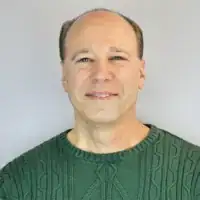 David BalkanDavid Balkan is a Professional Plumber, CEO of Balkan Sewer and Water Main Service, and President of Balkan Sewer and Drain Cleaning. As a hands-on owner of these companies for over 40 years, David is knowledgeable about water service lines, sewers, and drain line issues. David is a Committee Chairman of the Master Plumbers Council and has sat on the Executive Committee of the Sub Surface Plumbers Association of New York for over 30 years. His knowledge and solution-oriented approach contributed to Balkan Sewer and Water Main Service being the largest and most trusted service in New York City and the recipient of the 2017 Angie’s List Super Service Award.
David BalkanDavid Balkan is a Professional Plumber, CEO of Balkan Sewer and Water Main Service, and President of Balkan Sewer and Drain Cleaning. As a hands-on owner of these companies for over 40 years, David is knowledgeable about water service lines, sewers, and drain line issues. David is a Committee Chairman of the Master Plumbers Council and has sat on the Executive Committee of the Sub Surface Plumbers Association of New York for over 30 years. His knowledge and solution-oriented approach contributed to Balkan Sewer and Water Main Service being the largest and most trusted service in New York City and the recipient of the 2017 Angie’s List Super Service Award.
Professional Plumber & CEO of Balkan Sewer & Water Main Yes, every plumbing fixture should have one. Vents introduce air into your sewer system, which helps liquids flow smoothly through your pipes.
Yes, every plumbing fixture should have one. Vents introduce air into your sewer system, which helps liquids flow smoothly through your pipes. -
QuestionDo plumbing vents have to go through the roof?
 David BalkanDavid Balkan is a Professional Plumber, CEO of Balkan Sewer and Water Main Service, and President of Balkan Sewer and Drain Cleaning. As a hands-on owner of these companies for over 40 years, David is knowledgeable about water service lines, sewers, and drain line issues. David is a Committee Chairman of the Master Plumbers Council and has sat on the Executive Committee of the Sub Surface Plumbers Association of New York for over 30 years. His knowledge and solution-oriented approach contributed to Balkan Sewer and Water Main Service being the largest and most trusted service in New York City and the recipient of the 2017 Angie’s List Super Service Award.
David BalkanDavid Balkan is a Professional Plumber, CEO of Balkan Sewer and Water Main Service, and President of Balkan Sewer and Drain Cleaning. As a hands-on owner of these companies for over 40 years, David is knowledgeable about water service lines, sewers, and drain line issues. David is a Committee Chairman of the Master Plumbers Council and has sat on the Executive Committee of the Sub Surface Plumbers Association of New York for over 30 years. His knowledge and solution-oriented approach contributed to Balkan Sewer and Water Main Service being the largest and most trusted service in New York City and the recipient of the 2017 Angie’s List Super Service Award.
Professional Plumber & CEO of Balkan Sewer & Water Main Yes, they usually do. There are main vent lines that exit out the roof of a building, with other fixtures tying into these main lines.
Yes, they usually do. There are main vent lines that exit out the roof of a building, with other fixtures tying into these main lines. -
QuestionWhere should plumbing vents be placed?
 David BalkanDavid Balkan is a Professional Plumber, CEO of Balkan Sewer and Water Main Service, and President of Balkan Sewer and Drain Cleaning. As a hands-on owner of these companies for over 40 years, David is knowledgeable about water service lines, sewers, and drain line issues. David is a Committee Chairman of the Master Plumbers Council and has sat on the Executive Committee of the Sub Surface Plumbers Association of New York for over 30 years. His knowledge and solution-oriented approach contributed to Balkan Sewer and Water Main Service being the largest and most trusted service in New York City and the recipient of the 2017 Angie’s List Super Service Award.
David BalkanDavid Balkan is a Professional Plumber, CEO of Balkan Sewer and Water Main Service, and President of Balkan Sewer and Drain Cleaning. As a hands-on owner of these companies for over 40 years, David is knowledgeable about water service lines, sewers, and drain line issues. David is a Committee Chairman of the Master Plumbers Council and has sat on the Executive Committee of the Sub Surface Plumbers Association of New York for over 30 years. His knowledge and solution-oriented approach contributed to Balkan Sewer and Water Main Service being the largest and most trusted service in New York City and the recipient of the 2017 Angie’s List Super Service Award.
Professional Plumber & CEO of Balkan Sewer & Water Main It really depends on the vent. For example, if you were talking about a vent for your main sewer line in NYC, it'd get installed behind the house trap.
It really depends on the vent. For example, if you were talking about a vent for your main sewer line in NYC, it'd get installed behind the house trap.
Things You'll Need
- Plumbing and building codes
- Pipe configuration and layout
- Hardware store
- Measuring tape
- Pipe material
- Pipe fittings
- Ladder
- Hammer
- Nail
- Hole saw
References
- ↑ http://www.diffen.com/difference/ABS_vs_PVC
- ↑ http://water.me.vccs.edu/concepts/material.html
- ↑ http://inspectapedia.com/plumbing/Plumbing_Vent_Definitions.htm
- ↑ http://www.dummies.com/how-to/content/figuring-out-your-drainwastevent-lines.html
- ↑ David Balkan. Professional Plumber & CEO of Balkan Sewer & Water Main. Expert Interview. 29 April 2021.
- ↑ David Balkan. Professional Plumber & CEO of Balkan Sewer & Water Main. Expert Interview. 29 April 2021.
About This Article
Ventilation pipes prevent a vacuum from forming in your drain system and need to be connected to every plumbing fixture. If you have plumbing experience, you should be able to vent your plumbing by yourself. Check your local plumbing and building codes, since many places have specific restrictions about the size and material of your pipes. Generally, if your pipes are less than 10 inches in diameter, you should be able to use PVC or ABS pipes. If you need more durable pipes, go for ones made of copper, steel, or cast-iron. You’ll also need to choose between dry and wet venting. Dry venting is a simple system where each fixture has its own vent pipe. Wet venting is where one fixture’s vent is another fixture’s drain. This allows you to install several different fixtures in the same system of pipes, which is more complicated to set up, but uses fewer pipes. For more tips, including how to lay out your pipes, read on!

